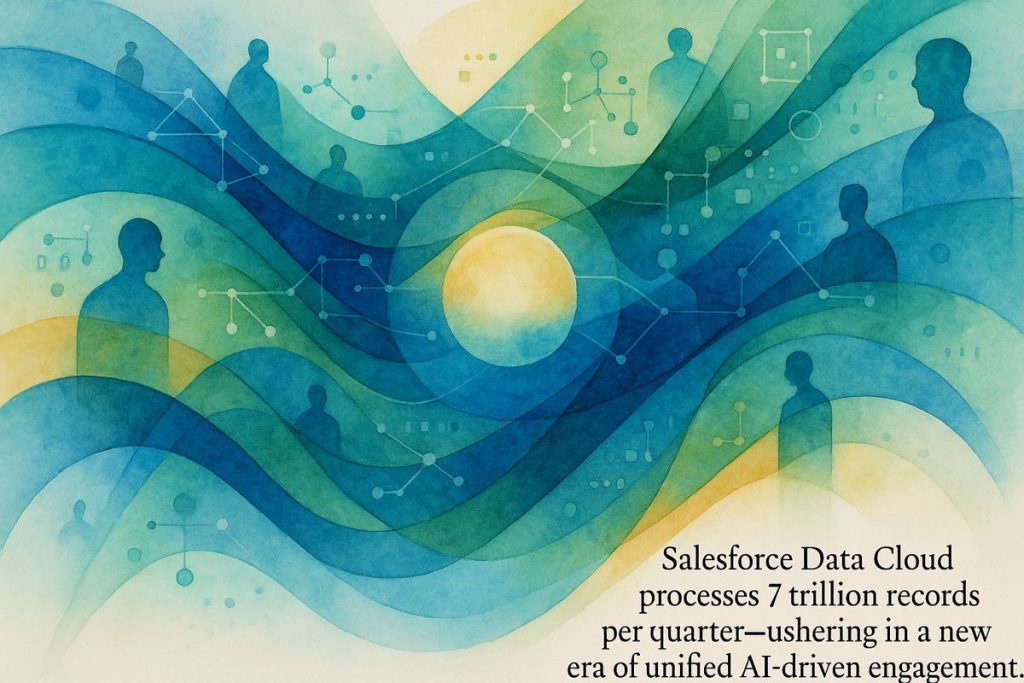Salesforce Data Cloud just hit a jaw-dropping $1 billion in recurring yearly revenue, showing explosive 120% growth and strong global adoption—especially in Europe. This platform connects perfectly with Customer 360, Tableau, and Slack, letting businesses work together in real time and use AI-powered insights. Agentforce, Salesforce’s automation tool, is gaining users fast and helps companies handle mountains of data quickly and smartly. Salesforce isn’t stopping there: big plans like acquiring Informatica aim to make their data cloud even more powerful. With these bold moves, Salesforce is shaping the future of business data and customer engagement.
What is Salesforce Data Cloud and why is its $1 billion ARR milestone significant?
Salesforce Data Cloud is a unified data platform that integrates seamlessly with Customer 360, Tableau, and Slack, enabling real-time collaboration and AI-powered insights. Reaching $1 billion in annual recurring revenue highlights its rapid 120% growth, industry adoption, and Salesforce’s dominant position in enterprise data solutions.
The $1 Billion Milestone: More Than Just a Number
Let’s start with the numbers, shall we? Salesforce Data Cloud just smashed through the $1 billion annual recurring revenue (ARR) barrier in the first quarter of fiscal year 2026—a figure that would make even the most stoic CFO spill their espresso. I had to stop and ask myself: does anyone else remember when “cloud” meant those fluffy things above Moscow, not hyperspectral customer records zipping between server farms in Oregon and Frankfurt? The scale is dizzying. But let’s not get ahead of ourselves.
This milestone isn’t just an idle vanity metric. According to Salesforce Ben and Salesforce’s own numbers, Data Cloud and its AI siblings are growing at a scorching 120% year-over-year. That’s not garden-variety expansion—that’s the digital version of a Siberian wildfire, consuming legacy data silos and sprouting new business models in its wake.
Big growth often breeds bigger headaches, but here’s the kicker: EMEA (Europe, Middle East, and Africa) is pulling ahead, outperforming Salesforce’s own global averages. Evidently, European banks, German automakers, and perhaps even a few French vintners are lapping up unified data like it’s the last café au lait before closing time. I have to admit, I once thought Americans would dominate the data cloud race, but now—eh, maybe it’s time to brush up on my German.
Agentforce, AI, and the Orchestra of Automation
If Data Cloud is the engine, then Agentforce is the fuel injection system. Salesforce’s Agentforce platform—a kind of digital conductor for your customer service orchestra—has seen over 8,000 deals inked last quarter, half of them paid. Paid users leapt from 3,000 to 4,000 in just three months, according to CIO Dive. (I’d insert a fireworks emoji, but let’s keep it classy.) Imagine watching your user base balloon quicker than a sourdough starter in July.
And the scale? Absurd. Data Cloud processed 7 trillion inbound records alongside 1.2 trillion engagement activations in a single quarter. That’s not just a metric—it’s an avalanche, the kind of data volume you can almost hear, a low digital hum reverberating through Salesforce’s metaphorical server halls. Is it possible to feel awe and exhaustion simultaneously? Apparently, yes.
There was a time—specifically, a Tuesday two years ago—when I fumbled a Data Cloud pilot for a client by misjudging their data velocity. Lesson learned: underestimate AI-driven orchestration at your peril. Since then, I can’t look at a well-automated Agentforce dashboard without a flicker of nervous pride. Ugh, the ghosts of failed demos past…
Unified Data: The Salesforce Polymath
But it isn’t just about brute force processing. Integration is Salesforce’s secret sauce—think of it as the umami of enterprise software. Data Cloud meshes harmoniously with Customer 360, Tableau, and Slack. Suddenly, every team—sales, service, marketing—has a single, unassailable source of data-truth. It’s like swapping your kitchen junk drawer for a hyperspectral Swiss Army knife.
Salesforce’s focus on a unified platform means business units can collaborate in real time, anticipating customer needs before they even articulate them. Tableau’s analytics add a layer of insight, while Slack injects a human texture—half banter, half workflow. You know that feeling when you walk into a bakery and the smell hits you—a sharp, yeasty promise of good things? Salesforce is trying to bottle that sensation for customer engagement.
Francois Zimmermann, Salesforce’s Field CTO, described the Data Cloud as the scaffolding for digital labor. In his conversation with Thomas Morgan, he stressed how companies can parlay unified data into operational agility and cost savings. I’ll admit, I’m still not sure if “operational agility” translates into fewer late-night calls from irate stakeholders—but one can dream.
Acquisitions, Ambitions, and the Road Ahead
No behemoth rests on its laurels. Salesforce’s imminent acquisition of Informatica is about to add some heavy-duty AI-powered master data management (MDM) and ETL muscle to the Data Cloud. If the deal closes, we’re looking at a platform with more layers than a mille-feuille. Morgan Stanley, never shy with a bold prediction, estimates these moves could tack on another $1 billion in annual revenue over two years (Morgan Stanley analysis). That’s not just ambitious; it’s borderline audacious.
CEO Marc Benioff—whose name now rings out in industry circles like some benevolent data tsar—has made clear that Data Cloud is Salesforce’s linchpin for the FY26 playbook. Revenue targets have been bumped up by $400 million to $41.3 billion. It’s the kind of executive swagger you can almost taste (hint
